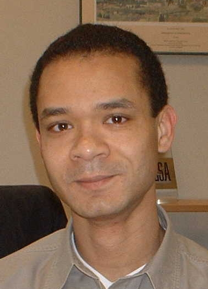Controlling mass transport in microcontact printing.
Promotion Date: 12 January 2006
| The principle of microcontact printing was conceived in order to bridge the gap between the expensive method of photolithography and cheap traditional printing methods, which are limited to a low resolution. |
What was your thesis about?
The principle of microcontact printing was conceived in order to bridge the gap between the expensive method of photolithography and cheap traditional printing methods, which are limited to a low resolution. In microcontact printing a flexible rubber stamp is used, together with a self-assembling dry ink. This principle has a built in disadvantage: the ink molecules are mobile, so on the small scale the ink also spreads. My job was to study that process. There was also an interest from Philips in the project, for at the time they were developing a large-area microcontact printing device and wanted to look into the technique’s limitations. In my thesis, while researching the spreading process, I’ve incidentally also addressed certain mechanical problems with the stamp.
What are the applications in which microcontact printing is used?
There are many. Because of its specific attributes, microcontact printing is a technique that is complimentary to other lithography techniques. It was invented as an alternative for photolithography, but it will probably never become competitive in terms of precision and resolution. There are, however, numerous applications in which those are of lesser importance. Microcontact printing allows easy, cheap and versatile micro-patterning of structures that can be functionalized at will, and is a particularly attractive tool for labs without a clean room facility.
And the problem of spreading is completely solved?
Yes and no. The major breakthrough was that we created a flat surface stamp with a fluorinated surface pattern forming a barrier for the ink, which in general solves the spreading problem. The used barrier, however, is not universally applicable and the use of flat stamps imposes new limitations on the applicability of the technique. But on the whole it is an important step forward.
Is that why you made it to the UT News?
That’s because Philips has decided to protect some ideas that came forth from this research in a total of four patents.
You did two years of your PhD research at Philips, why was that?
Philips wanted this research to fit in with what they are doing themselves in their research, so we agreed that I would have a look around for about two months. The aim of the project was to look into the problem of spreading on a molecular scale, using STM (Scanning Tunneling Microscopy). But at that time they did not have one available to me at Philips, so I joined the microcontact printing project using different techniques; the aim still being the research of spreading. This altered approach proved successful for all parties and I was allowed to stay there for two years. Afterwards it turned out that STM wouldn’t have worked anyway. After those two years I had initiated a couple of patents, but hadn’t as yet written articles, so I went back to the university to see to the scientific side of things.
Didn’t you miss the scientific atmosphere in the first two years?
Working with Philips Research is quite different from what you’d expect from working in an industry. It is a very scientific environment, employing globally about 2,100 researchers. It is like a university without students. And I could very much find my own way; there was nobody telling me what to do – I really enjoyed it.
Are you still with Philips?
No, I am looking for a job right now. I would like to stay in research, doing a postdoc. Although postdoctoral projects are often very interesting, there is the disadvantage that they are temporary positions only, whereas I also would like a bit more stability to build a future. An academic career is also very competitive, so you really have to choose well.
For the summary of the thesis, click here.

